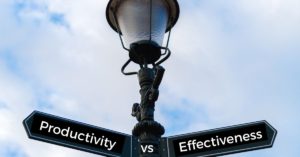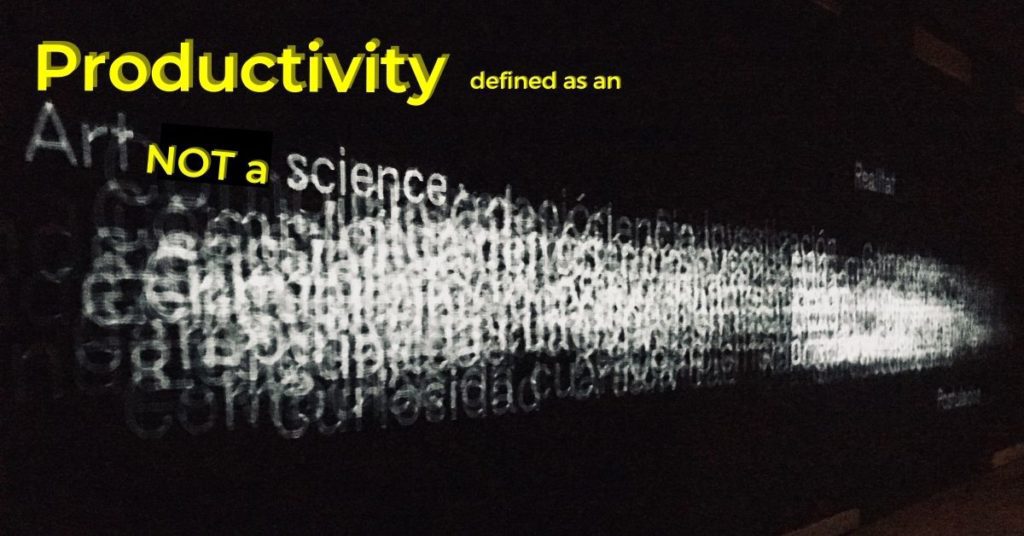Productivity is a word often used without the understanding of what is meant by it. This can leave employees feeling confused & frustrated. What exactly does it mean? It’s time to rethink it!
When we think about productivity, we tend to think, are people busy? Are they efficient? Are they using their time well?
Profitability and employee morale are benefits that appear in a productive workplace. Many companies still struggle with creating a productive work environment.
One of the keys is understanding how to accomplish goal completion in a timely manner without sacrificing the quality of work.
 In this blog post we dive deep into the traditional views about productivity in the workplace. We’ll also be sharing some common misconceptions about productivity.
In this blog post we dive deep into the traditional views about productivity in the workplace. We’ll also be sharing some common misconceptions about productivity.
Workplace productivity is traditionally defined as how much work gets accomplished in a work environment over a certain period of time.
There are two primary drivers behind productivity. Motivation and clarity. With these aspects in place, you can set employees free to be productive on their own terms vs. setting up boundaries/barriers/parameters to ensure they are productive.
on a macro level
On a macro level, productivity in North America is way down. Measured as output in the economy versus the number of hours people work. This does not come as a surprise.
Many employees are still working from home, the truth is most people don’t get everything out of their work day when they are at home. It’s really hard to do. Sure, you may have tackled everything on your to-do list but the refinement, bouncing ideas off others, and brainstorming that rounds out productivity, is impossible to replicate in a virtual workspace.
Even though employees are still reporting working the same number of hours, the output is down.
on a micro level
On a micro level, productivity is seen as how much work you get done vs. how much time or energy you put into it. Productivity is usually viewed as a science. It is viewed as something that can be easily measured and something where we can actually manage the ratio & numbers from the outside; however, that is missing the point.
By observation, it is hard to assess the productivity of an employee. Do you focus on just clocking hours? If you were to walk into an office with everyone’s eyes glued to their screen and keyboards clacking, does that give the impression of productivity instead of a collaborative environment where people are engaging in conversation?
There’s so much more of a dynamic between people that goes into productivity but that’s quite difficult to see with the naked eye.
Keystrokes, mouse movement & meetings doesn’t necessarily achieve the goal of moving the most important tasks forward over other less observable & measurable actions.
An important thing to remember is you can be extremely busy and not productive at all. You could also not be busy yet be very productive. More often than not, unproductive behaviors take more energy than productive ones.
So what are some common misconceptions about productivity?
We’ve been told some of these examples since entering the workforce. It might surprise some people these practices do not necessarily make you productive.
Being a multitasker means you’re efficient
Switching back and forth between tasks means your brain goes through two phases. Goal shifting and rule activation. Rule activation is the act of turning off rules for one task and turning them on for the next. Going through this switch can cost time and mental energy.
Constantly going through this process can cost precious productive time. One task could have been completed during that time instead of completing half of two.
Being the first one in the office means you are productive
If you are not a morning person, that’s nothing to be ashamed of. Stick to times when you are at your most productive. By sticking to times when you are at your most productive, you give yourself a chance to do your best work.
The Internet is one big distraction affecting productivity
This might be true if you don’t have the skills to efficiently use your time while using it. However, It is recommended to take time and unplug too! It can be an incredible tool to help you find exactly what you need in a short time frame!
Working from home is unproductive
Many workplaces still discourage working from home as they think there are too many distractions. Did you know employees are often happier working from home? While there is nothing wrong with working in an office, there are some people who simply find they are more productive in a different setting. Whether it be their home office, a coffee shop, or a library; what works for one person might not work for another.
When it comes down to it, people are typically wired to want to have impact and move projects forward. Morale goes up when productivity goes up. This creates lasting & sustainable productivity. When employees feel like they are being watched and constantly measured by team leaders, it only provides short term improvements.
It might feel that in order to be productive, everything needs to be perfect. This tendency is often unmotivating to workers. By giving your people permission to do their best, creating that safe workspace, and embracing how they work best; this is encouraging and uplifting to them.
Effectiveness vs. Efficiency
It is possible for a team to be effective, but not perfect and not optimally efficient.
Instead of people talking about productivity, they should have more discussions about effectiveness, motivation & clarity.
Do people know what is expected of them to be successful? Are they the kind of people who really want to succeed? If they aren’t, they shouldn’t be in your organization. Instead of wasting resources trying to over-manage them and change their attitude, set them free and let them find their own success elsewhere.
That is your recipe for success.
In short, to micro-evaluate productivity would be a waste of resources and would have the opposite impact on productivity.
How are you rethinking productivity in your workplace? Share your thoughts below.
Patrick Lencioni talks about “The Truth about Virtual Productivity” in his podcast and whether or not ‘the new normal’ is sustainable.
At NexLevel, we’re experts in building healthy organizations through cohesive teams and engaged employees. We will help you and your employees become the high-performance team you’ve always wanted to be by focusing on collaboration, creativity, culture, and connection.
Ready to get started? Get a snapshot of your company’s overall health.
“Take our FREE Organizational Health Survey” https://nexlevelteams.com/org-health-survey-form/




